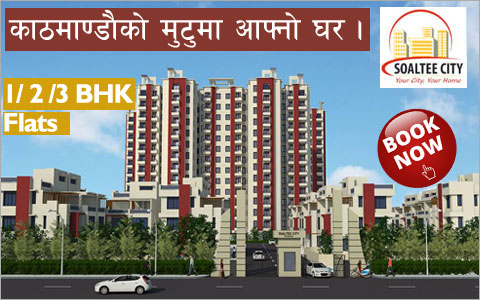National News

The real estate market, that remained moribund for the last three years, is gradually creeping back to life, but transactions are yet to reach the peak of 2008-09. In the last fiscal year ended July 15, various land revenue offices in the country collected Rs 5.36 billion in registration fees, up from Rs 4.80 billion recorded in the previous fiscal year.
Although last fiscal’s registration fee collection — one of the most reliable indicators to gauge real estate transactions — marks a hike of 11.67 per cent, the amount is still way below Rs 6.31 billion registered in 2008-09, when the property market was at its peak.
“Besides, 11.67 per cent increment is very nominal as most of the districts increase valuation of land by around 10 per cent every year, which plays a great role in expanding registration fee collection of land revenue offices,” director general of the Department of Land Reform and Management (DoLRM) Tej Raj Pandey said. “But this should not mean transactions have not gone up. The only thing is they are going up slowly.”
Transactions, especially in Kathmandu Valley, had scaled to a height never seen before in 2008-09 due to easy availability of loans for speculative purposes. With this, land prices were doubling within a short period of time and many were lured into placing bets, hoping of quick returns.
But the market started cooling after Nepal Rastra Bank tightened the noose around speculating lending. In one instance, it asked banks and financial institutions to reduce realty credit exposure to 30 per cent of total lending by mid-July 2011 and 25 per cent by mid-July 2012. Subsequently, the central monetary authority also asked banking institutions to put a 60-per cent cap on loans issued against security of real estate.
But since the central bank had given enough time to banking institutions to reduce their exposure, lending of commercial banks to the sector continued to increase and reached an all time high of Rs 98.96 billion in mid-January 2011. It then fell.
DoLRM data on Kathmandu valley shows that land transaction registration fee, which had topped Rs 3.84 billion in 2008-09, had hovered at Rs 2.52 billion the next year and further plunged to Rs 1.32 billion in 2010-11. Since then the market is picking up with registration fee collection reaching Rs 1.78 billion in 2011-12 and Rs 2.53 billion in 2012-13, according to DoLRM statistics.
The trend is similar in major real estate markets outside the valley. In Kaski district, land registration fee collection stood at Rs 288.96 million last fiscal year as against Rs 211.56 million in the same period in the previous fiscal year.
Chitwan also recorded 21.66 per cent hike in land registration fee to Rs 213.01 million in last fiscal, while fee collection in eastern district of Morang stood at Rs 226.17 million last fiscal from Rs 203.08 million recorded in the previous fiscal.
source: the himalayan times,31 July 2013
- 9th Nepal Buildcon International Expo 2024
- Real Estate Expo 2023
- NRB raises housing loan limit to encourage home constructions
- Nepal Rastra Bank (NRB) Monetary Policy 2080-2081
- New Price of Land in Kathmandu Metropolitan City, Nepal
- Capital Gains Tax Rate on Real Estate Transactions in Nepal 2080-81 ( 2023/24 )
- Kathmandu metropolis implements free parking policy for commercial buildings and hospitals

![[X]](https://www.housingnepal.com/images/popup-close-button.png)























































































































































































































































































































































































 Facebook
Facebook
 Delicious
Delicious
 Digg
Digg
 Reddit
Reddit
 Stumble Upon
Stumble Upon









